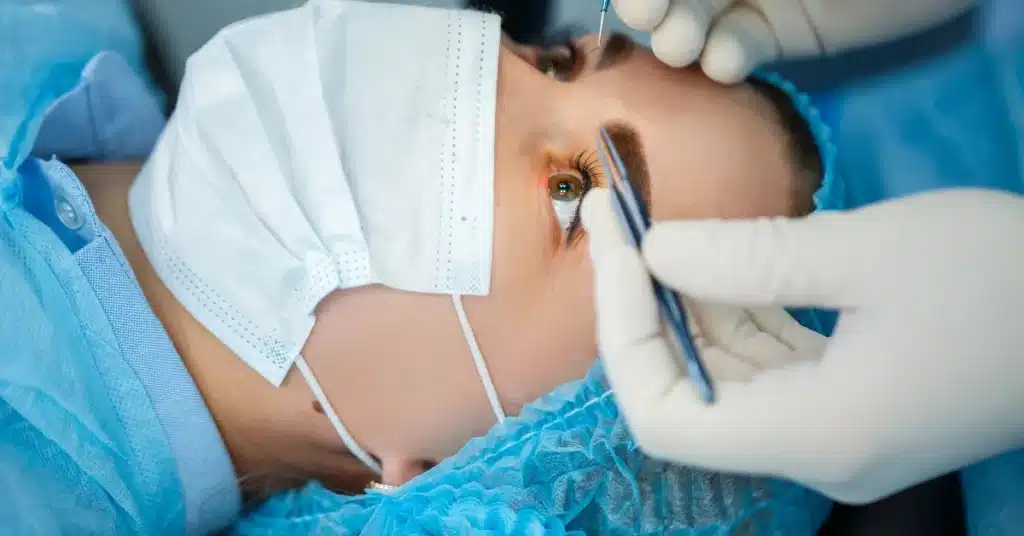Cataract surgery is a procedure which removes the eye’s lens and replaces it with an artificial lens.
There are several types of Cataract surgeries available.
They include small-incision Cataract surgery and extracapsular surgery.
This article will discuss types of Cataract surgery in detail to help people find the most suitable option based on individual needs.
Understanding Cataract surgery
Cataracts often form slowly, resulting in a gradual impairment of vision.
Cataract surgery is frequently performed under the influence of local anesthesia (a numbing gel) and light intravenous sedation.
A small incision is made to remove the Cataract. Still, the incision is usually small enough that stitches are not required.
Phacoemulsification (a type of ultrasound) is the most common type of Cataract surgery.
Another option is Laser-Assisted Cataract Surgery (LACS), utilizing laser technology for precise treatment.
The choice of Cataract surgery depends on factors like Cataract symptoms, severity, and individual needs.
Read “Average Age for Cataract Surgery” for insights on the optimal time to enhance your vision.
Types of Cataract Surgery
 Source: pixel_shots
Source: pixel_shotsCataract surgery offers different approaches to address vision issues caused by cloudy lenses.
There are three types of Cataract surgery: Phacoemulsification, Extracapsular surgery, and Femtosecond laser.
Let’s discuss these types of Cataract surgery:
Phacoemulsification
Phacoemulsification is a procedure where a tiny incision is created along the side of the cornea.
It is the clear, dome-shaped surface that covers the eye’s front.
The doctor inserts a tiny probe into your eye. The ultrasonic waves from the devices reduce and break up the lens.
The broken lens is then removed using suction.
Extracapsular surgery
Extracapsular Cataract surgery involves removing the entire cloudy lens through a larger incision.
The lens’ cloudy center is then removed in one piece. At the same time, suction is used to remove the remaining lens.
Although less common than phacoemulsification, this technique may be preferred for advanced Cataracts.
Read Extracapsular Cataract Extraction Explained: The Surgical Approach
Femtosecond laser
It is an additional option for your doctor to consider during Cataract surgery.
The femtosecond laser is an FDA-approved, computer-guided laser programmed by the surgeon.
This device can assist the surgeon in completing the necessary measures to remove Cataracts.
It can also be used in procedures to treat Astigmatism.
Types of lenses for Cataract surgery
 Source: Getty_images
Source: Getty_imagesCataract surgery offers various lens options tailored to individual needs.
While all intraocular lenses are utilized to restore vision clarity, many implant options are also available.
Some common Cataract lenses are standard, premium lenses, and toric IOLs.
Let’s discuss these lenses for better understanding:
Standard lens implants
Standard lenses are monofocal and developed to correct vision at one definite focal length.
Patients using IOLs that correct far vision in both eyes will most likely require reading glasses.
Some people choose an intraocular lens (IOL) that corrects close vision in one eye while improving distance vision in the other.
Premium intraocular lenses
Premium IOLs include presbyopia-correcting IOLs and the Toric IOLs.
Presbyopia-correcting IOLs aim to enhance distance and near vision, reducing reliance on glasses.
Toric IOLs specifically address Astigmatism, correcting both distance vision and Astigmatism.
Some people cannot have an IOL placed in their eyes because they may have eye conditions or other complications during surgery.
Such patients may be given high-magnification glasses or soft contact lenses.
Summing up
Cataract surgery is a common and successful treatment for visual loss caused by Cataracts.
Several methods of Cataract surgery are available, including phacoemulsification, extracapsular surgery, and the femtosecond laser.
The choice of Cataract surgery type depends on the severity and symptoms of Cataracts.
Choosing the most appropriate IOL is crucial for achieving optimal outcomes.
Based on their requirements, patients can select from conventional lenses to premium IOLs, such as Presbyopia-correcting and Toric lenses.
It is essential to consult a doctor to choose a suitable type of Cataract surgery for your condition.
Frequently Asked Questions
What type of Cataract surgery is best?
Laser-assisted Cataract surgery is the most advanced technique for doing Cataract surgery.
Many doctors prefer laser Cataract surgery over traditional Cataract surgery as an initial treatment to ‘soften’ Cataracts.
What is the difference between Extracapsular and Intracapsular Cataract extraction?
Extracapsular Cataract extraction involves removing the cloudy lens while leaving the posterior capsule intact, often requiring a larger incision.
Intracapsular extraction removes the entire lens, including the surrounding capsule.
Extracapsular is more common, while intracapsular is less frequently performed due to increased surgical complexity and risks.
Are there any risks associated with laser-assisted Cataract surgery?
While generally safe, risks associated with laser-assisted Cataract surgery include eye infection, inflammation, and potential vision disturbances.
It’s crucial to discuss individual risk assessments with the surgeon before opting for this procedure.
What time of year is best for Cataract surgery?
Cataract surgery can be scheduled at any time of the year.
The choice often depends on personal preferences and healthcare provider availability.
It is important to consult with your eye care professional to determine the best timing for your surgery based on individual considerations.
What are the side effects of Cataract surgery?
There are several side effects of Cataract surgery, with intensity and duration varying.
Common short-term effects include light sensitivity, blurry vision, and dry eyes.
Uncommon effects may include bleeding, or swelling. Long-term issues like lens misalignment or persistent inflammation may occur.
When referencing outside resources, GoodrxMedicine always provides full citations. To learn more about the measures we use to maintain the quality of our content, please review our Content Information Policy.











